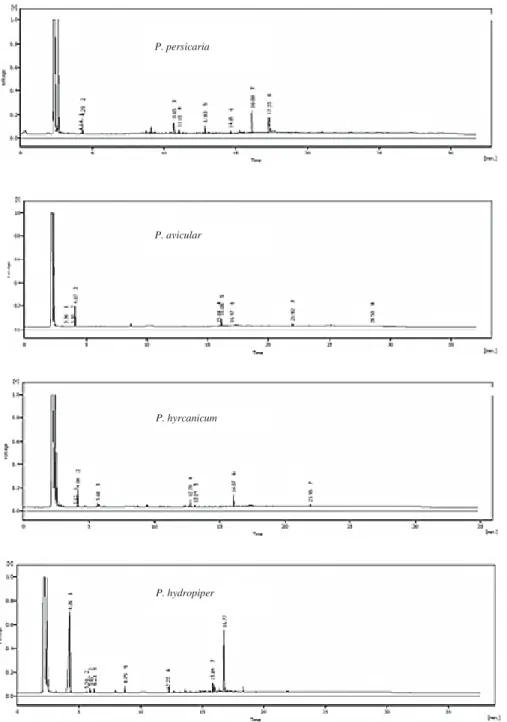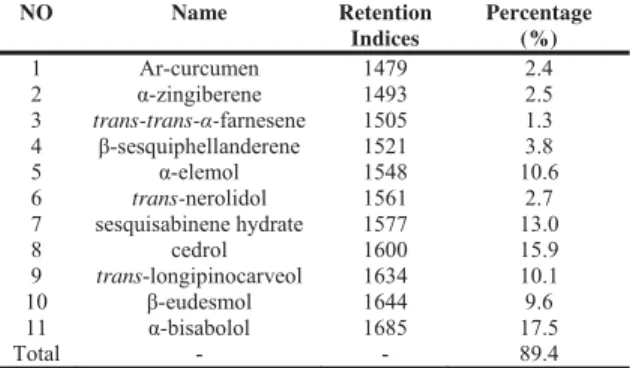Available at: http://rjpharmacognosy.ir/ Copy right© 2014 by the Iranian Society of Pharmacognosy
Research Journal of Pharmacognosy (RJP) 1, 2014: 3-7 Received: Aug 2013
Accepted: Nov 2013
Original article
GC/Mass analysis of the volatile compounds of
P. hyrcanicum
diethyl
ether extract and GC profiling of some Iranian
Polygonum
species
S. Saeidnia
1, P. Sarkhail
2, F. Moradi-Afrapoli
3, A.R. Gohari
1*, M. Nikan
1, N.
Mokhber-Dezfuli
1, G.R. Amin
4, A. Hadjiakhoondi
1,41
Medicinal Plants Research Center, Tehran University of Medical Sciences, Tehran, Iran.
2
Pharmaceutical Sciences Research Center, Tehran University of Medical Sciences, Tehran, Iran.
3
Faculty of Pharmacy, Mazandaran University of Medical Sciences, Sari, Iran.
4
Department of Pharmacognosy, Faculty of Pharmacy, Tehran University of Medical Sciences, Tehran, Iran.
Abstract
In this study, the relationship among four species of Polygonum (including P. hyrcanicum
(three samples), P. persicaria, P. avicular, and P. hydropiper) was investigated by GC profiling. Furthermore, the major compounds of the ethylic ether extract of P. hyrcanicum
were identified by GC/MS as: -bisabolol (17.5%), cedrol (15.9%), sesquisabinene hydrate (13.0%), -elemol (10.5%) and trans-longipinocarveol (10.1%). All the identified compounds were sesquiterpenes and no monoterpene, fatty acid and/or hydrocarbone were detected in the extract. Chemical distances among the mentioned species were calculated in order to construct the dendrogram of closely related samples. Results indicated that the distance between two samples of P. hyrcanicum was considered to be short and their GC profiles were quite similar to each other and also there was a close relationship between the two samples of
Polygonum with P. avicular. P. hydropiper was observed far from the two samples of P. hyrcanicum in comparison to other samples. Interestingly, P. hyrcanicum, gathered from Veresk, had no close relationship with other pairs of P. hyrcanicum.The results of this study support the phylogenetic relationships among these Polygonum species which was previously reported.
Keywords: P. avicular, P. hydropiper, P. hyrcanicum, P. persicaria, volatile compounds
Introduction
The genus Polygonum L. (Polygonaceae), named “Alafe-Haftband” in Persian language, grows as a wild weed in diverse parts of Iran. P. hyrcanicum and P. persicaria are two examples of its nine endemic species [1,2]. It is reported that Polygonum (especially their rhizomes) were used for the treatment of atherosclerosis, hypertension and dermatitis [3].
4
(10.8%), caryophyllene (9.3%) and (E)-nerolidol (6.9%), [5]. In another study, the major compounds of the volatile oil of P. hydropiper were identified as dodecanal (3– 40%), (E)-2-hexenal (20–35%), decanal (4– 22%), (Z)-3-hexen-1-ol (4–31%), hexanal (1.7–5.1%) and -caryophyllene (1.7–2.3%) [6].Literature review showed that chemotaxonomic (using volatile constituents as chemical markers) investigation of the Polygonum species have not been reported until now. Recently, we have reported the phylogenetic comparison and genetic diversity of some wild species of this genus [7]. In the present study, we have focused on comparing some species (growing in Iran) via GC profiling and UPGMA analysis of the diethyl ether extracts together with the GC/Mass analysis of the volatile ether extract of P. hyrcanicum which has not been published elsewhere.
Experimental
Plant material
Plant samples of four Polygonum species including P. hyrcanicum Rech. f. (three samples), P. persicaria Boiss & Bushe, P. avicular L., and P. hydropiper L. subsp. hydropiper were collected during the flowering period from diverse growing areas in North of Iran (July 2010). The plant materials were dried in shade. The voucher specimens (P. hyrcanicum, 6729-TEH; P. persicaria, 6733-TEH; P. avicular, 6731-TEH, and P. hydropiper L. subsp. hydropiper, 6735-TEH) have been deposited at the Herbarium of the Faculty of Pharmacy, Tehran University of Medical Sciences, Tehran, Iran.
Detection of the main volatile components Leaves of the plants (30 g) were dried, cut into small pieces and extracted by ethylic ether (10 mL) at 4 ºC for 24 h. A silica gel cartridge was used for removing the chlorophyll [8]. The extracts were concentrated using nitrogen gas to the approximate volume of 0.3 mL. Each concentrated extract was injected to the Gas Chromatograph.
GC was carried out using a Dani Master GC (Fast Gas Chromatograph) with OV1 (SE54CB, 25 m×0.25 mm i.d., 0.25 μm film
thickness); carrier gas, N2; split ratio, 1:20, and flame ionization detector (FID). Temperature programming was performed from 75 ºC (4 min) to 250 qC (14 min) at 15 ºC/min, injector temperature 250 qC and detector temperature 260 ºC.
GC/Masswas performed on a cross-linked 5% methyl phenyl siloxane (HP-5, 30 m×0.25 mm i.d., 0.25 μm film thickness), carrier gas, He; split ratio, 1:15; quadruple mass spectrometer (Hewlett-Packard 5973) operating at 70 eV ionization energy. The retention indices for all the components were calculated by using retention times of n-alkanes (C8-C25) that were injected at the same temperature and conditions, after the essential oil. The components were identified by comparing the retention indices (RI, DB-5 or DB-1) with those reported in the literatures [9, 10] and also by comparing their mass spectra with the published mass spectra [11] or Wiley library. The percentage of each component was calculated on the basis of the peak area.
Results and Discussion
Pair-wise comparison of GC profiles revealed a similar matrix. Simple matching coefficients (Ssm) and chemical distances (d), derived from GC profiles, are shown in table 1. The distance between the two samples of P. hyrcanicum originated from Sari and Goharbaran regions, was considered to be short (0.790) and their GC fingerprint patterns were quite similar to each other; also there was a close relationship between these two samples of Polygonum with P. avicular (0.826). The cladogram and rectangular phylogram, constructed on the basis of chemical distances derived from GC analyzing, are shown in figure 1. The GC chromatograms for the diethyl ether extracts of four Polygonumn species are shown as a sample in figure 2. Clustering analysis was carried out on the basis of UPGMA (unweighted pair-group method arithmetic average) [12,13]. The cladograms were designed by the software Dendroscope which is freely available from www.dendroscope.org [14].
5
Figure 1. Cladogram and rectangular phylogram of the Polygonum samples obtained from GC profiling and on the basis of UPGMA
Figure 2. GC chromatograms of the diethyl ether extracts of four Polygonum species (P. hyrcanicym was gathered from Sari).
P. hyrcanicum O P. hyrcanicum S P. avicular P. persicaria P. hyrcanicum V P. hydropiper
P. hyrcanicum O P. hyrcanicum S P. avicular P. persicaria P. hyrcanicum V P. hydropiper
P. persicaria
P. avicular
P. hyrcanicum
6
hyrcanicum, but it also showed different patterns of GC fingerprint compared to the other samples.
It was also interesting that P. hyrcanicum, gathered from Veresk, had no close relationship to the other pairs of P. hyrcanicum (from Sari and Goharbaran).
A survey on the main morphological characters of the Polygonum species [15]
indicated that P. hydropiper was
morphologically different from P. hyrcanicum, specially, in case of the leaves shape and color and size of the flowers. Moreover, oval lance shaped leaves of P. avicular and P. hyrcanicum showed similarities to each other which were in agreement with the results of GC profiling and genetic diversity [6]. There is no report about the phytochemical investigation of two endemic species of Iran, P. hyrcanicum and P. persicaria. One of the interesting points obtained from this study is that P. hyrcanicum (gathered from Veresk village near the top of Gadook Mountain) showed different GC profile and RAPD/ISSR
pattern from other samples even P.
hyrcanicum (Goharbaran and Sari near the Caspian Sea).
Table 1. Simple matching coefficient (Ssm, above the diagonal) and distances (d, below the diagonal) between pairs of Polygonum samples resulted from GC profiling
1 2 3 4 5 6 1 --- 0.067 0.100 0.200 0.100 0 2 0.966 --- 0.133 0.067 0.154 0.059 3 0.949 0.930 --- 0.300 0.333 0.071 4 0.894 0.967 0.837 --- 0.375 0.077 5 0.949 0.920 0.816 0.790 --- 0.083 6 1 0.970 0.964 0.960 0.961 ---
The samples used in this analysis were: P. hyrcanicum
(three samples including Goharbaran (4), Sari (5) and Veresk (2)), P. persicaria (1), P. avicular (3), and P. hydropiper (6).
Table 2. Chemical composition of the ethylic ether extract of P. hyrcanicum gathered from Veresk
NO Name Retention Indices
Percentage (%) 1 Ar-curcumen 1479 2.4
2 -zingiberene 1493 2.5
3 trans-trans-Į-farnesene 1505 1.3 4 -sesquiphellanderene 1521 3.8
5 -elemol 1548 10.6
6 trans-nerolidol 1561 2.7 7 sesquisabinene hydrate 1577 13.0
8 cedrol 1600 15.9
9 trans-longipinocarveol 1634 10.1
10 -eudesmol 1644 9.6
11 -bisabolol 1685 17.5
Total - - 89.4
For this reason the ethylic ether extract of this sample was selected for GC/Mass analysis. The results of GC/Mass analysis has been summarized in table 2. As it is shown, the major compounds of the ethylic ether extract
of P. hyrcanicum were -bisabolol (17.5%), cedrol (15.9%), sesquisabinene hydrate (13.0%), -elemol (10.6%) and trans-longipinocarveol (10.1%). All the identified compounds were sesquiterpenes (C15) and no monoterpene, fatty acid and /or hydrocarbon were detected in the extract which made this sample different from other samples of P. hyrcanicum. On the basis of our unpublished data, the volatile oils of P. hyrcanicum and P. persicaria extracted by hydro-distillation have completely different main compounds and are commonly enriched of fatty acids.
Acknowledgements
This research has been supported by Tehran University of Medical Sciences and Health Services for plant gathering and identification.
References
[1] Mozaffarian V. A Dictionary of Iranian Plant Names. Tehran: Farhange Moaser, 2008. [2] Rechinger KH. Flora Iranica, Polygonaceae.
Graz: Akademische Druck-und Verlagsanstalt, 1986.
[3] Yi T, Leung KS, Lu GH, Zhang H, Chan K. Identification and determination of the major constituents in traditional Chinese medicinal plant Polygonum multiflorum Thunb by HPLC coupled with PAD and ESI/MS. Phytochem Analysis. 2007; 18: 181-187.
[4] Datta B, Datta S, Rashid M, Nash R, Sarker S. A sesquiterpene acid and flavonoids from
Polygonum viscosum. Phytochemistry. 2000; 54: 201-205.
[5] Miyazawa M, Tamura N. Components of the essential oil from sprouts of Polygonum hydropiper L. (‘Benitade’). Flavour Fragr J.
2007; 22: 188-190.
[6] Jiang J. Volatile composition of the laksa plant (Polygonum hydropiper L.), a potential source of green note aroma compounds. Flavour Fragr J. 2005; 20: 455-459.
7
Polygonum species growing in North of Iran.
Afr J Biotechnol. 2011; 10(82): 18981-18986. [8] Hostettmann K, Marston A, Hostettmann M.
Preparative Chromatography Techniques. 2nd ed. Berlin: Springer, 1998.
[9] Saeidnia S, Gohari AR, Yassa N, Shafiee A. Composition of the volatile oil of Achillea conferta DC. from Iran. Daru. 2005; 13(1): 34-36.
[10] Gohari AR, Hadjiakhoondi A, Sadat-Ebrahimi E, Saeidnia S, Shafiee A. Composition of the volatile oils of Satureja spicigera C. Koch Boiss. and S. macrantha C. A. Mey from Iran.
Flavour Fragr J. 2006; 21(3): 510-512.
[11] Adams RP. Identification of essential oil components by gas chromatography/mass spectroscopy. Carol Stream: Allured Publishing, 1995.
[12] Rhodes AM, Malo SE, Campbell CW, Carmer SG. A numerical taxonomic study of the avocado (Persea americana Mill.). J Amer Soc Hort Sci. 1971; 96: 391-395.
[13] Wu H, Chou C, Chang TL, Chen IZ. Genetic relationships estimation of Taiwan Avocado cultivars by volatile constituents of leaves. Proceedings of the 6th World Avocado Congress. 2007 Nov 12-16; Viña Del Mar, Chile.
[14] Huson DH, Richter DC, Rausch C, Dezulian T, Franz M, Rupp R. Dendroscope: An interactive viewer for large phylogenetic trees . BMC Bioinformatics. 2007; 8: 460.
[15] Ghahreman A. Colored Flora of Iran. Tehran: Research Institute of Forests and Rangelands, 1975-2000.

